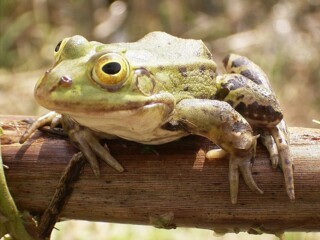Frogs Porn
Jenny Diski · Reading the Entrails
Some days anything will do as news. For example, we learn from the BBC's Earth News that some (though not all) toads may (or may not) have advance warning of earthquakes. Unfortunately, the toad watchers,having serendipitously observed toads leaving home a few days before the 6.3-magnitude earthquake struck l'Aquila in 2009, couldn't quite put their finger on how the toads sensed it was on its way. A bit of a rumble, I shouldn't wonder. But since they were 74 km away, they might just have decided to have a weekend break, since only mating pairs or males took off – spinster toads stayed home. On top of the unknowability of what, how and if the toads knew, the report rather eeyoreishly adds that:
It is hard to objectively and quantifiably study how animals respond to seismic activity, in part because earthquakes are rare and unpredictable.
This is almost as reliable a way of prognosticating natural events as gazing into the entrails of chickens. Not quite, because you can arrange to have a chicken around, but who is going to watch all the toads in the world in case some of them get antsy and do a runner? Speaking of which, the report includes the information that a species of desert harvester ants in the Mojave Desert failed to respond at all to a 7.4-magnitude quake in 1992.A control experiment of sorts, I suppose.
I am, as it happens, much taken with amphibians at the moment. About fifteen frogs in my teeny garden-pond have just finished mating (in time to avoid mini-me winter). Toads, it seems, are frogs,or so it says on a froggish web site , though whether frogs are toads I'm not quite clear about. I saw from the upstairs window that the surface of the water appeared to be boiling and kept going out to have a look. Every time, sensing my footsteps as I walked towards the pond (a clue here to earthquake watch?) they all disappeared with many plops, leaving nothing by the time I got there but an increasing smear of frogspawn.
Over a few days I perfected my wildlife stalking skills, and before they'd quite done with each other, I managed to creep very, very slowly – a flask of reviving tea at my hip – and catch them at it. A lumpy carpet of sex-demented frogs covered the 5′x 3′ pond. More like bubble wrap, with their glazed buggy eyes bulging above the top of the water, seeming to see nothing but their own internal drive, and a mess of bodies over, under and between each other, rigidly still, intensely concentrated, completing the job evolution demanded of them. Then a couple of days ago they were gone, leaving the pond covered with a seething mass of dark writhing specks wiggling in jelly.
The local cats will gather soon and peer over the edge, and make their plans. Then, when the specks have broken out of their transparent gloop and are bigger, with a leg or two, the surviving tadpoles will start eating each other and being eaten by the dragonfly larvae lurking at the bottom of the pond, until eventually, by early summer, a final handful of froglets will one day no longer be there.After that, there'll be no way of knowing when the earth is about to move until next spring.

Comments
http://www.google.co.uk/intl/en/landing/translateforanimals/
http://www3.interscience.wiley.com/cgi-bin/fulltext/123337858/HTMLSTART
I know nothing about toads, but the graphs look quite convincing.